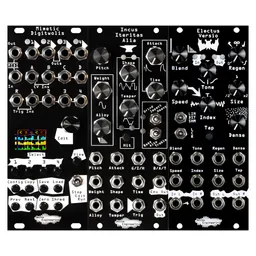Welcome back to Getting Started, the series where we explore fundamental concepts in Eurorack. Today, we’ll be talking about a function that’s common on many modules: normaling.
What is normaling?
Normaling is, on paper, a very simple concept, but in use can be somewhat complex. On some modules, a particular input will be normaled to another input, or set of inputs. That means that if you plug a signal into one jack, it will act like that signal was plugged into all the jacks that are normaled together. It’s a bit like there’s a mult built into the module.

Breaking normals
If two jacks are normaled together, and you plug one signal into one jack, it will go to both jacks. However, if you plug a second signal into the second jack, then the normal is broken – that is, the first signal is no longer copied to the second jack, and instead, it’s controlled by the second signal.

In this picture, the four input jacks are normaled together, but a second signal breaks the normal.
As with many things in modular, this is one of those concepts that makes more sense once you make a few patches with modules that use normaling.
Going a bit further: circular vs. unidirectional normaling
The last detail we need to explore about normaling is rather subtle. Some modules circularly normal: a good example of this is Pons Asinorum, where any one trigger input can trigger all four channels (that is, a trigger into input 3 will trigger channel 4 below it, but also channels 1 and 2 above it, and of course channel 3). Other modules only normal from top to bottom: Quantus Ampla’s CV inputs normal down, so if you plug a signal into CV channel 1 it will be copied to all four channels, but a signal going into channel 3 will only be copied to channel 4.

Why is normaling important?
Normaling is generally used to make common connections easier. For instance, on our Loquelic Iteritas oscillator, the pitch inputs for both oscillators A and B are normalled together; in many patches it’s useful for both oscillators to track the same pitch sequence, so it saves having to use a mult.
Another use of normalling is to make complex pre-planned patches easier. A good example of this is the Make Noise DPO: it has a timbre section with three parameters that respond well to audio-rate modulation. One of its oscillators is normalled to all three of those parameters: each parameter has its own CV input so that normalization can be broken with an external signal, but the internal normling sets up a great-sounding patch without any patch cables.
Breaking normals part 2
The normalled inputs on the Loquelic Iteritas and Make Noise DPO are handy, but what if we don’t want that -- or any -- signal sent to the normal? This is easy if perhaps a little inelegant looking: you just patch a cable into the jack without patching the other end of the cable to anything. This “tells” the second jack that it shouldn’t use the signal from the first jack and disconnects it. Easy!
How can I find out what’s normaled to what?
Figuring out what’s normaled to what on your modules is important, as it changes how you can patch. This is another spot where reading the user manuals for your modules is important: they should tell you if anything is normaled to anything else, and you can use that info to understand what’s going on before you plug any cables in, and often to make your patches much simpler!
A note on terminology
Sometimes you’ll see normaling called normalizing. Some sources appear to use the terms interchangeably but since normalizing has other meanings in the audio world, we try to stick to normaling for this use case, just for clarity.







